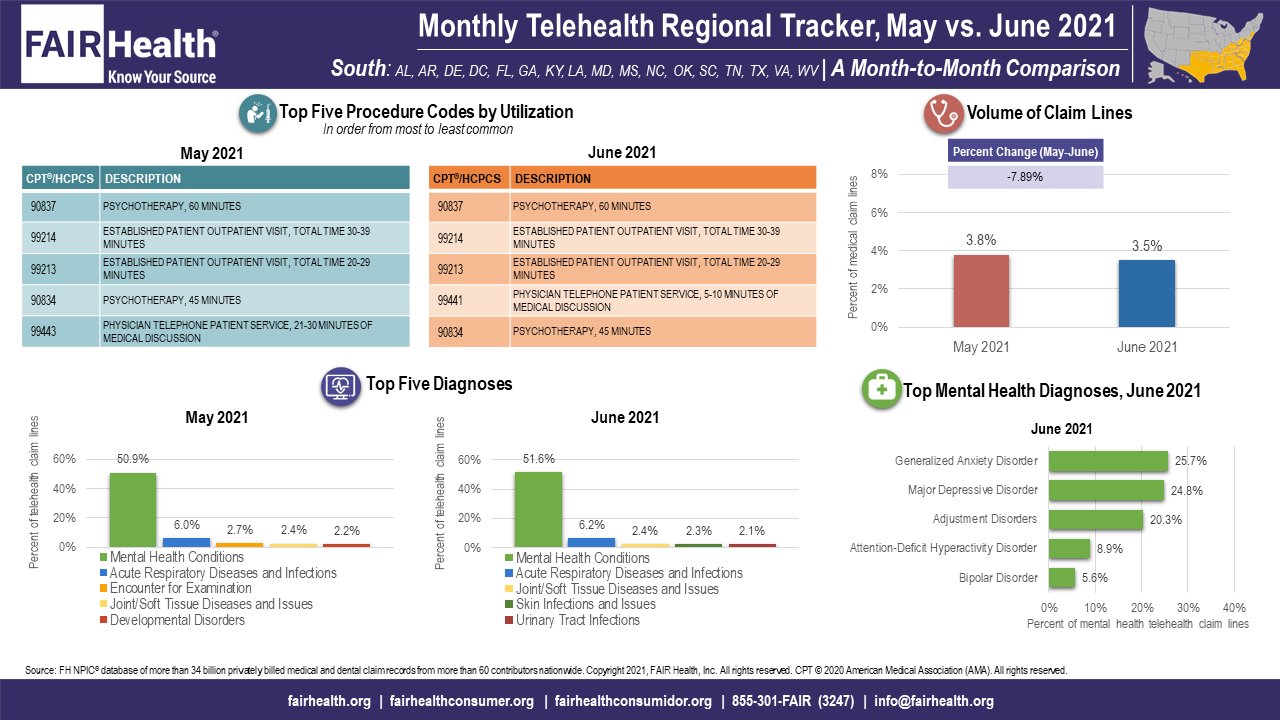- Center on Health Equity & Access
- Clinical
- Health Care Cost
- Health Care Delivery
- Insurance
- Policy
- Technology
- Value-Based Care
After a Month of Stability, National Telehealth Utilization Declined 10 Percent in June 2021
After a month of stable utilizations, use of telehealth services dropped 10% in June 2021, according to Robin Gelburd, JD, president of FAIR Health.
After a month of stability, national telehealth utilization declined in June 2021, according to FAIR Health’s Monthly Telehealth Regional Tracker. Telehealth utilization, measured as a percentage of all medical claim lines, fell 10 percent nationally from May to June 2021, decreasing from 5 percent of medical claim lines in May to 4.5 percent in June (Exhibit 1). By comparison, telehealth utilization rose 2 percent nationally from April to May 2021, following decreases each month from February to April. The data represent the privately insured population, including Medicare Advantage and excluding Medicare Fee-for-Service and Medicaid.
Exhibit 1. Monthly Telehealth Regional Tracker, May versus June 2021, United States
(Source: FAIR Health)

In all four US census regions, telehealth claim lines fell from May to June 2021 as a percentage of medical claim lines just as they did nationally, with the sharpest decrease occurring in the Northeast. In that region, telehealth utilization dropped 11.9 percent from May to June 2021.
Other changes from May to June 2021 involved the top five telehealth diagnoses. Joint/soft tissue diseases and issues rose in the rankings of top five telehealth diagnoses nationally and in every region but the West. Nationally, this diagnosis rose from number four in May, with 2.5 percent of telehealth claim lines, to number three in June, with 2.6 percent of telehealth claim lines.
Acute respiratory diseases and infections rose nationally from number three among telehealth diagnoses in May 2021 to number two in June. Nationally and in every region, mental health conditions remained in the number one spot among telehealth diagnoses and continued to increase in percentage of telehealth claim lines.
Urinary tract infections appeared in fifth place among telehealth diagnoses in the South in June 2021 (Exhibit 2). This was the first time since the start of the pandemic in March 2020 that this diagnosis appeared on the regional or national lists, although it had been common on the lists prior to the pandemic.
Exhibit 2. Monthly Telehealth Regional Tracker, May versus June 2021, South
(Source: FAIR Health)

About the Monthly Telehealth Regional Tracker
Launched in May 2020 as a free service, the Monthly Telehealth Regional Tracker uses FAIR Health data to track how telehealth is evolving from month to month. An interactive map of the four US census regions allows the user to view an infographic on telehealth in a specific month in the nation as a whole or in individual regions. Each infographic shows month-to-month changes in volume of telehealth claim lines, top five telehealth procedure codes and top five telehealth diagnoses (or diagnostic categories), along with that month’s top five granular diagnoses within the most common diagnostic category.
As the COVID-19 pandemic continues to evolve, FAIR Health’s Monthly Telehealth Regional Tracker reveals accompanying changes in telehealth. The Telehealth Tracker is one of the ways we pursue our healthcare transparency mission.
For the Monthly Telehealth Regional Tracker, click here.
Robin Gelburd, JD, is the founding President of FAIR Health, a national, independent nonprofit organization that serves as a trusted leader in healthcare cost transparency, data analytics and benchmarks. FAIR Health possesses the nation’s largest collection of private healthcare claims data, which includes over 35 billion claim records and grows at a rate of over 2 billion claim records a year. Certified by the Centers for Medicare & Medicaid Services as a national Qualified Entity, FAIR Health also receives data representing the experience of all individuals enrolled in traditional Medicare Parts A, B and D. Robin is a nationally recognized expert on healthcare policy and health literacy and transparency. Selected as one of Crain’s 2019 Notable Women in Health Care, she has been invited to speak to organizations and federal and state agencies across the country and world.
CPT © 2020 American Medical Association (AMA). All rights reserved.
